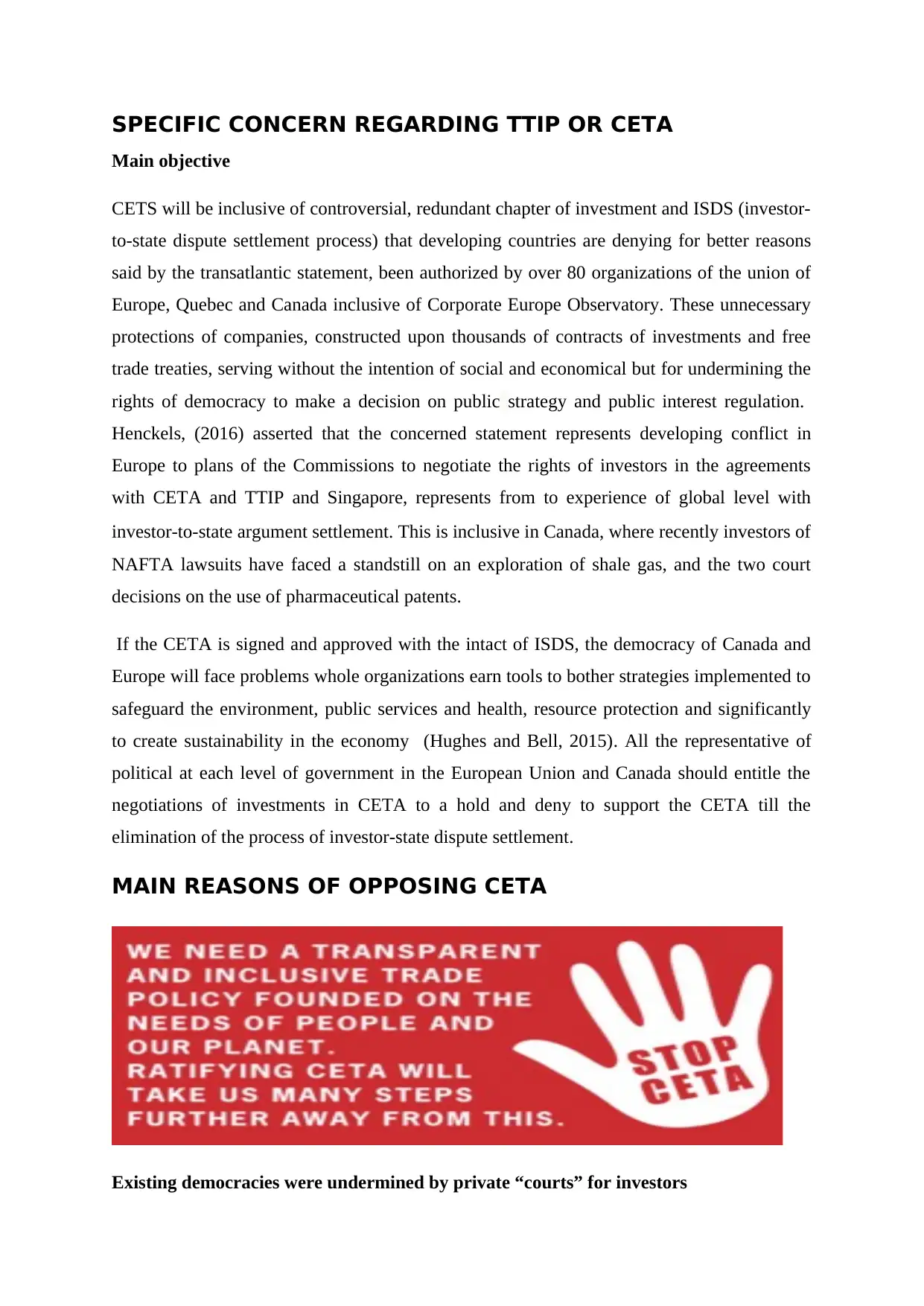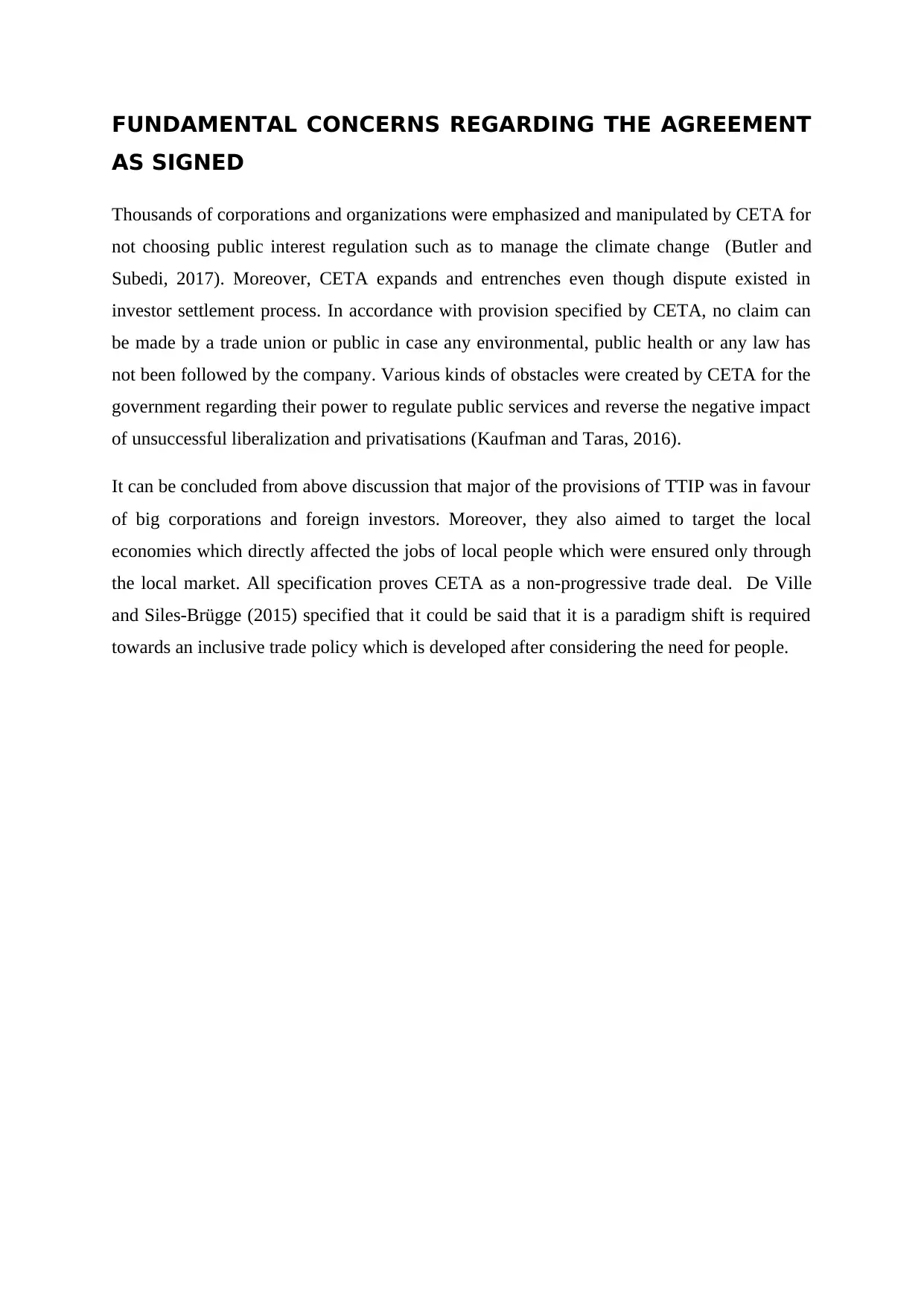CUPE's Opposition to CETA: Trade Agreement Impacts and Concerns
VerifiedAdded on 2020/04/21
|8
|2007
|39
Essay
AI Summary
This essay examines the Canadian Union of Public Employees (CUPE)'s opposition to the Comprehensive Economic and Trade Agreement (CETA), focusing on the concerns regarding investor-state dispute settlement, foreign investor rights, and the impact on public services and local economies. The essay highlights CUPE's decentralized structure and its role in representing workers in various sectors. It discusses the potential negative impacts of CETA, including the undermining of existing democracies through private "courts" for investors, the provision of freedom to foreign service providers in public areas, negative impacts on long-term patent rights relating to drugs, and creating hurdles for local economies. The analysis emphasizes how CETA could manipulate public interest regulations, expand investor settlement processes, and create obstacles for governments in regulating public services, concluding that the agreement primarily benefits big corporations and foreign investors at the expense of local economies and public interest.

Modern Society
17
17
Paraphrase This Document
Need a fresh take? Get an instant paraphrase of this document with our AI Paraphraser

It is believed that European and Canadian Trade officials met to continue the discussion of
the provision of CETA and TTIP (Transatlantic Trade & Investment Partnership). The same
is deemed to be a threat for ordinary people as it provides more support to foreign investors
and big corporations rather than the public organization (Van Harten, 2014). It is one of the
main reason due to which same was opposed by Canadian as well as European societies.
Present essay revolves around the discussion relating to the reason due to which CANADIAN
UNION OF PUBLIC EMPLOYEES society opposed the specified agreements. Moreover,
the overall impact of these agreements has also been discussed.
CANADIAN UNION OF PUBLIC EMPLOYEES
CUPE which stands for The Canadian Union of Public Employee is a trade union of Canada
delivering the public sector; however, recently it was in organized workplaces of non-profit
as well as para-public. CPE is one of the largest Canadian unions, demonstrating approx
650000 workers engaged in healthcare, universities, transportation, airlines, libraries
education, social services, education, public utilities, and emergency services. More than 60%
of members of CUPE are females, and one-third is part-time workers. CUPE is in united with
CLC (Canadian Labour Congress) and is a leading contributor of finance,
History
CUPE was first established in 1963 in an industry unionism that resembles fashion through
integrating NUPE (National Union of Public Employees) and NUPSE (National Union of
the provision of CETA and TTIP (Transatlantic Trade & Investment Partnership). The same
is deemed to be a threat for ordinary people as it provides more support to foreign investors
and big corporations rather than the public organization (Van Harten, 2014). It is one of the
main reason due to which same was opposed by Canadian as well as European societies.
Present essay revolves around the discussion relating to the reason due to which CANADIAN
UNION OF PUBLIC EMPLOYEES society opposed the specified agreements. Moreover,
the overall impact of these agreements has also been discussed.
CANADIAN UNION OF PUBLIC EMPLOYEES
CUPE which stands for The Canadian Union of Public Employee is a trade union of Canada
delivering the public sector; however, recently it was in organized workplaces of non-profit
as well as para-public. CPE is one of the largest Canadian unions, demonstrating approx
650000 workers engaged in healthcare, universities, transportation, airlines, libraries
education, social services, education, public utilities, and emergency services. More than 60%
of members of CUPE are females, and one-third is part-time workers. CUPE is in united with
CLC (Canadian Labour Congress) and is a leading contributor of finance,
History
CUPE was first established in 1963 in an industry unionism that resembles fashion through
integrating NUPE (National Union of Public Employees) and NUPSE (National Union of

Public Service Employees). Stan little was the first national president; previously he was the
president of NUPSE. Enclosing a public sector union by which no workers were entitled to
strike, Stan has given the authority to bring the public sector unions back to collective
bargaining from collective begging. At the time of retirement of Stan, CUPE developed into
210,000 associates and had concealed United Steelworkers as a leading member to the CLC
EXISTING ORGANIZATIONAL STRUCTURE
CUPE has a much-decentralized structure in which every local vote for their own executive,
set out its structure, carry out own bargaining, and conduct own votes and further pass on to
national and division meeting to structure overarching strategy. Advocated present in the
process claim that the authority is put in the grassroots to which it relates (Petersman, 2016).
CUPE’s decentralized structure is defined as the supreme strength as well as the weakness of
CUPE. The decentralization of politics is reflected by a decentralization of organization.
However, CUPE has its own national headquarters located in Ottawa, and is comparatively
small- most of the majority of staff are spread across more than 70 offices throughout the
country.
Provincial divisions
Divisions of CUPE are political member’s voice in their own internal parts and provinces.
Chartered via the national union, every divisional advocate at the level of provinces for
strategies, legislative and political change in the standards and interest of members of CUPE.
Every division of province is directed by elected president having democratic characteristics,
the board of executive and secretary-treasurer who are further led by members at yearly
conventions (Healy, 2014).
Internal labour relations
Employees of CUPE have divided into two key units of bargaining. The CSU (Canadian Staff
Union) is the largest group among all. It presents representatives of national level and
professional members in that Area office over the 10 CUPE regions. During 2008, CSU
engaged the union of managerial and technical members which demonstrated approx 60
managerial and technical members at the national office of Ottawa.
president of NUPSE. Enclosing a public sector union by which no workers were entitled to
strike, Stan has given the authority to bring the public sector unions back to collective
bargaining from collective begging. At the time of retirement of Stan, CUPE developed into
210,000 associates and had concealed United Steelworkers as a leading member to the CLC
EXISTING ORGANIZATIONAL STRUCTURE
CUPE has a much-decentralized structure in which every local vote for their own executive,
set out its structure, carry out own bargaining, and conduct own votes and further pass on to
national and division meeting to structure overarching strategy. Advocated present in the
process claim that the authority is put in the grassroots to which it relates (Petersman, 2016).
CUPE’s decentralized structure is defined as the supreme strength as well as the weakness of
CUPE. The decentralization of politics is reflected by a decentralization of organization.
However, CUPE has its own national headquarters located in Ottawa, and is comparatively
small- most of the majority of staff are spread across more than 70 offices throughout the
country.
Provincial divisions
Divisions of CUPE are political member’s voice in their own internal parts and provinces.
Chartered via the national union, every divisional advocate at the level of provinces for
strategies, legislative and political change in the standards and interest of members of CUPE.
Every division of province is directed by elected president having democratic characteristics,
the board of executive and secretary-treasurer who are further led by members at yearly
conventions (Healy, 2014).
Internal labour relations
Employees of CUPE have divided into two key units of bargaining. The CSU (Canadian Staff
Union) is the largest group among all. It presents representatives of national level and
professional members in that Area office over the 10 CUPE regions. During 2008, CSU
engaged the union of managerial and technical members which demonstrated approx 60
managerial and technical members at the national office of Ottawa.
⊘ This is a preview!⊘
Do you want full access?
Subscribe today to unlock all pages.

Trusted by 1+ million students worldwide

SPECIFIC CONCERN REGARDING TTIP OR CETA
Main objective
CETS will be inclusive of controversial, redundant chapter of investment and ISDS (investor-
to-state dispute settlement process) that developing countries are denying for better reasons
said by the transatlantic statement, been authorized by over 80 organizations of the union of
Europe, Quebec and Canada inclusive of Corporate Europe Observatory. These unnecessary
protections of companies, constructed upon thousands of contracts of investments and free
trade treaties, serving without the intention of social and economical but for undermining the
rights of democracy to make a decision on public strategy and public interest regulation.
Henckels, (2016) asserted that the concerned statement represents developing conflict in
Europe to plans of the Commissions to negotiate the rights of investors in the agreements
with CETA and TTIP and Singapore, represents from to experience of global level with
investor-to-state argument settlement. This is inclusive in Canada, where recently investors of
NAFTA lawsuits have faced a standstill on an exploration of shale gas, and the two court
decisions on the use of pharmaceutical patents.
If the CETA is signed and approved with the intact of ISDS, the democracy of Canada and
Europe will face problems whole organizations earn tools to bother strategies implemented to
safeguard the environment, public services and health, resource protection and significantly
to create sustainability in the economy (Hughes and Bell, 2015). All the representative of
political at each level of government in the European Union and Canada should entitle the
negotiations of investments in CETA to a hold and deny to support the CETA till the
elimination of the process of investor-state dispute settlement.
MAIN REASONS OF OPPOSING CETA
Existing democracies were undermined by private “courts” for investors
Main objective
CETS will be inclusive of controversial, redundant chapter of investment and ISDS (investor-
to-state dispute settlement process) that developing countries are denying for better reasons
said by the transatlantic statement, been authorized by over 80 organizations of the union of
Europe, Quebec and Canada inclusive of Corporate Europe Observatory. These unnecessary
protections of companies, constructed upon thousands of contracts of investments and free
trade treaties, serving without the intention of social and economical but for undermining the
rights of democracy to make a decision on public strategy and public interest regulation.
Henckels, (2016) asserted that the concerned statement represents developing conflict in
Europe to plans of the Commissions to negotiate the rights of investors in the agreements
with CETA and TTIP and Singapore, represents from to experience of global level with
investor-to-state argument settlement. This is inclusive in Canada, where recently investors of
NAFTA lawsuits have faced a standstill on an exploration of shale gas, and the two court
decisions on the use of pharmaceutical patents.
If the CETA is signed and approved with the intact of ISDS, the democracy of Canada and
Europe will face problems whole organizations earn tools to bother strategies implemented to
safeguard the environment, public services and health, resource protection and significantly
to create sustainability in the economy (Hughes and Bell, 2015). All the representative of
political at each level of government in the European Union and Canada should entitle the
negotiations of investments in CETA to a hold and deny to support the CETA till the
elimination of the process of investor-state dispute settlement.
MAIN REASONS OF OPPOSING CETA
Existing democracies were undermined by private “courts” for investors
Paraphrase This Document
Need a fresh take? Get an instant paraphrase of this document with our AI Paraphraser

Investors in foreign were offered special rights to the case not in favour of the nation if they
had a belief that the reformed laws and regulation created a negative impact on their business
(DUDÁŠ and DUDÁŠOVÁ, 2016). At present, Canada is supposed to have significant legal
penalties and a growing country. It was approved by both of the countries that rights will be
given to Investor Company as per the new acronym. Conversely, the reason for this
controversy was that the special rights were given to foreign investors and it resulted in
declining of the present court system of EU and Canada.
The provision provided freedom to Foreign Service provider in public areas
For the first time, a trade agreement regarding the negative list meant for services was
negotiated. By considering the consequence, various services have been excluded
government of Europe which includes new public services that will be unlocked
automatically. Moreover, while competing with the providers of foreign service, this
mechanism has been filled by CUPE and other communities as standstill and ratchet section
in confine and future liberalisation. Brouse, Nguyen and Lohschelder (2015), stated that it is
supposed that this will result in complexities to get the services back under public ownership.
Negative impact on long-term patent right relating to drugs
It was considered that demand for European Union pharmaceutical patent could increase the
current scenario of health care costs of Canada’s province by adding up billion in it through
protecting patent rights regarding long drugs. An estimate was made by researchers that the
reform in the security of patents for pharmaceutical drugs will terminate the cost from $850
million to $1.65 billion on a yearly basis (Wathen, MacGregor and MacQuarrie, 2015). The
society of CUPE stands against CETA with other societies as well, as CETA gave provision
for creating barriers for the government of Europe in terms of reducing the patent period.
Creating hurdles for local economies
CETA emphasized to break the provision which was available for providing an advantage to
local communities and municipalities. The European Union made efficient efforts for deletion
of Canadian buy local programs which ensure the local jobs. The same was analyzed by the
Council of Canadians. The laws and provision which assisted local business were targeted by
multinational companies so that they able to attain whole profit (Kelly and Bourgeault, 2015).
Due to same reason Canadian societies were against.
had a belief that the reformed laws and regulation created a negative impact on their business
(DUDÁŠ and DUDÁŠOVÁ, 2016). At present, Canada is supposed to have significant legal
penalties and a growing country. It was approved by both of the countries that rights will be
given to Investor Company as per the new acronym. Conversely, the reason for this
controversy was that the special rights were given to foreign investors and it resulted in
declining of the present court system of EU and Canada.
The provision provided freedom to Foreign Service provider in public areas
For the first time, a trade agreement regarding the negative list meant for services was
negotiated. By considering the consequence, various services have been excluded
government of Europe which includes new public services that will be unlocked
automatically. Moreover, while competing with the providers of foreign service, this
mechanism has been filled by CUPE and other communities as standstill and ratchet section
in confine and future liberalisation. Brouse, Nguyen and Lohschelder (2015), stated that it is
supposed that this will result in complexities to get the services back under public ownership.
Negative impact on long-term patent right relating to drugs
It was considered that demand for European Union pharmaceutical patent could increase the
current scenario of health care costs of Canada’s province by adding up billion in it through
protecting patent rights regarding long drugs. An estimate was made by researchers that the
reform in the security of patents for pharmaceutical drugs will terminate the cost from $850
million to $1.65 billion on a yearly basis (Wathen, MacGregor and MacQuarrie, 2015). The
society of CUPE stands against CETA with other societies as well, as CETA gave provision
for creating barriers for the government of Europe in terms of reducing the patent period.
Creating hurdles for local economies
CETA emphasized to break the provision which was available for providing an advantage to
local communities and municipalities. The European Union made efficient efforts for deletion
of Canadian buy local programs which ensure the local jobs. The same was analyzed by the
Council of Canadians. The laws and provision which assisted local business were targeted by
multinational companies so that they able to attain whole profit (Kelly and Bourgeault, 2015).
Due to same reason Canadian societies were against.

FUNDAMENTAL CONCERNS REGARDING THE AGREEMENT
AS SIGNED
Thousands of corporations and organizations were emphasized and manipulated by CETA for
not choosing public interest regulation such as to manage the climate change (Butler and
Subedi, 2017). Moreover, CETA expands and entrenches even though dispute existed in
investor settlement process. In accordance with provision specified by CETA, no claim can
be made by a trade union or public in case any environmental, public health or any law has
not been followed by the company. Various kinds of obstacles were created by CETA for the
government regarding their power to regulate public services and reverse the negative impact
of unsuccessful liberalization and privatisations (Kaufman and Taras, 2016).
It can be concluded from above discussion that major of the provisions of TTIP was in favour
of big corporations and foreign investors. Moreover, they also aimed to target the local
economies which directly affected the jobs of local people which were ensured only through
the local market. All specification proves CETA as a non-progressive trade deal. De Ville
and Siles-Brügge (2015) specified that it could be said that it is a paradigm shift is required
towards an inclusive trade policy which is developed after considering the need for people.
AS SIGNED
Thousands of corporations and organizations were emphasized and manipulated by CETA for
not choosing public interest regulation such as to manage the climate change (Butler and
Subedi, 2017). Moreover, CETA expands and entrenches even though dispute existed in
investor settlement process. In accordance with provision specified by CETA, no claim can
be made by a trade union or public in case any environmental, public health or any law has
not been followed by the company. Various kinds of obstacles were created by CETA for the
government regarding their power to regulate public services and reverse the negative impact
of unsuccessful liberalization and privatisations (Kaufman and Taras, 2016).
It can be concluded from above discussion that major of the provisions of TTIP was in favour
of big corporations and foreign investors. Moreover, they also aimed to target the local
economies which directly affected the jobs of local people which were ensured only through
the local market. All specification proves CETA as a non-progressive trade deal. De Ville
and Siles-Brügge (2015) specified that it could be said that it is a paradigm shift is required
towards an inclusive trade policy which is developed after considering the need for people.
⊘ This is a preview!⊘
Do you want full access?
Subscribe today to unlock all pages.

Trusted by 1+ million students worldwide

REFERENCES
Brouse, K., Nguyen, V. and Lohschelder, S., 2015. CUSLI expert roundtable report: CETA,
TPP, TTIP, and the Canada-US trade relationship. Canada-United States Law Journal, 39,
pp.202-208.
Butler, N. and Subedi, S., 2017. The Future of International Investment Regulation: Towards
a World Investment Organisation?. Netherlands International Law Review, 64(1), pp.43-72.
De Ville, F. and Siles-Brügge, G., 2015. TTIP: The truth about the transatlantic trade and
investment partnership. John Wiley & Sons.
DUDÁŠ, T. and DUDÁŠOVÁ, M., 2016. Growing Skepticism towards Transatlantic Trade
and Investment Partnership in Europe–Causes and Consequences. Editorial Board, p.1.
Healy, T., 2014. Canadian and European Unions and the Canada—EU CETA
Negotiations. Globalizations, 11(1), pp.59-70.
Henckels, C., 2016. Protecting Regulatory Autonomy through Greater Precision in
Investment Treaties: The TPP, CETA, and TTIP. Journal of International Economic
Law, 19(1), pp.27-50.
Hughes, J. and Bell, D., 2015. Bargaining for contract academic staff at English Canadian
universities. WorkingUSA, 18(3), pp.377-394.
Kaufman, B.E. and Taras, D.G., 2016. Nonunion employee representation: history,
contemporary practice and policy. Routledge.
Kelly, C. and Bourgeault, I.L., 2015. The Personal Support Worker Program Standard in
Ontario: An Alternative to Self-Regulation?. Healthcare Policy, 11(2), p.20.
Petersmann, E.U., 2016. The European Union’s ‘Cosmopolitan Foreign Policy Constitution
and Its Disregard in Transatlantic Free Trade Agreements. European Foreign Affairs
Review, 21(4), pp.449-468.
Van Harten, G., 2014. Comments on the European Commission’s Approach to Investor-State
Arbitration in TTIP and CETA. Browser Download This Paper.
Brouse, K., Nguyen, V. and Lohschelder, S., 2015. CUSLI expert roundtable report: CETA,
TPP, TTIP, and the Canada-US trade relationship. Canada-United States Law Journal, 39,
pp.202-208.
Butler, N. and Subedi, S., 2017. The Future of International Investment Regulation: Towards
a World Investment Organisation?. Netherlands International Law Review, 64(1), pp.43-72.
De Ville, F. and Siles-Brügge, G., 2015. TTIP: The truth about the transatlantic trade and
investment partnership. John Wiley & Sons.
DUDÁŠ, T. and DUDÁŠOVÁ, M., 2016. Growing Skepticism towards Transatlantic Trade
and Investment Partnership in Europe–Causes and Consequences. Editorial Board, p.1.
Healy, T., 2014. Canadian and European Unions and the Canada—EU CETA
Negotiations. Globalizations, 11(1), pp.59-70.
Henckels, C., 2016. Protecting Regulatory Autonomy through Greater Precision in
Investment Treaties: The TPP, CETA, and TTIP. Journal of International Economic
Law, 19(1), pp.27-50.
Hughes, J. and Bell, D., 2015. Bargaining for contract academic staff at English Canadian
universities. WorkingUSA, 18(3), pp.377-394.
Kaufman, B.E. and Taras, D.G., 2016. Nonunion employee representation: history,
contemporary practice and policy. Routledge.
Kelly, C. and Bourgeault, I.L., 2015. The Personal Support Worker Program Standard in
Ontario: An Alternative to Self-Regulation?. Healthcare Policy, 11(2), p.20.
Petersmann, E.U., 2016. The European Union’s ‘Cosmopolitan Foreign Policy Constitution
and Its Disregard in Transatlantic Free Trade Agreements. European Foreign Affairs
Review, 21(4), pp.449-468.
Van Harten, G., 2014. Comments on the European Commission’s Approach to Investor-State
Arbitration in TTIP and CETA. Browser Download This Paper.
Paraphrase This Document
Need a fresh take? Get an instant paraphrase of this document with our AI Paraphraser

Wathen, C.N., MacGregor, J.C. and MacQuarrie, B.J., 2015. The impact of domestic violence
in the workplace: results from a pan-Canadian survey. Journal of occupational and
environmental medicine, 57(7), p.e65.
in the workplace: results from a pan-Canadian survey. Journal of occupational and
environmental medicine, 57(7), p.e65.
1 out of 8
Related Documents
Your All-in-One AI-Powered Toolkit for Academic Success.
+13062052269
info@desklib.com
Available 24*7 on WhatsApp / Email
![[object Object]](/_next/static/media/star-bottom.7253800d.svg)
Unlock your academic potential
Copyright © 2020–2025 A2Z Services. All Rights Reserved. Developed and managed by ZUCOL.


